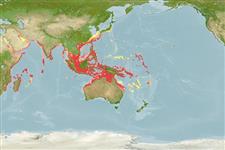Environment: milieu / climate zone / depth range / distribution range
Ekologi
laut; payau dasar (demersal); oceanodromus (Ref. 51243); kisaran kedalaman 10 - 90 m (Ref. 12260), usually 20 - 60 m (Ref. 114285). Tropical; 36°N - 28°S, 33°E - 180°E
Indo-West Pacific: East Africa to southeast Asia, north to China, south to northern Australia and Fiji (Ref. 12743).
Length at first maturity / Size / Weight / umur
Maturity: Lm 9.9, range 9 - 10.3 cm
Max length : 23.0 cm TL jantan/; (Ref. 30573); common length : 20.0 cm TL jantan/; (Ref. 5450)
Duri punggung (Keseluruhan (total)) : 8; duri punggung lunak (Keseluruhan (total)) : 9; Duri dubur: 1; Sirip dubur lunak: 7. This species is distinguished by the following characters: D VIII,9; pectoral fins 15-16; gill rakers 7-8 + 19-21 = 27-28; lateral line scales 34-37; body depth at first dorsal-fin origin 29-33% SL and at anus 25-27% SL; caudal-peduncle depth 11-12% SL; maximum head depth 23-25% SL; head depth through eye 18-20% SL; head length 29-30%SL; orbit length 7.4-8.7% SL; upper jaw length 11-13% SL; barbel length 17-21% SL; caudal-fin length 27-30% SL; anal-fin height 16-18% SL; pelvic-fin length 20-22% SL; pectoral-fin length 24-26% SL; first dorsal-fin height 23-26% SL; second dorsal-fin height 17-18% SL; no bars on caudal-fin lobes; yellowish lower lobe base, grey on upper lobe (some of the caudal-fin lobe pigmentation retained when preserved, including inner margin of fin lobes); 2 yellow body stripes, 1 mid-lateral body from operculum to caudal-fin base (both faintly retained in preserved fish); white barbels; body dorsally pale brown and ventrally white (pale brown with some reddish or darker brown area at mid-body in preserved fish) (Ref. 82903).
Found in coastal waters, entering estuaries (Ref. 30573). Sandy-muddy bottom (Ref. 43239). Forms schools (Ref. 5213). Has appearance of sillaginids when schooling (Ref. 48636).
Life cycle and mating behavior
Kematangan | Reproduksi, perkembang biakan | Pemijahan | telur-telur | Fecundity | Larva
Kumaran, M. and J.E. Randall, 1984. Mullidae. In W. Fischer and G. Bianchi (eds.) FAO species identification sheets for fishery purposes. Western Indian Ocean fishing area 51. Vol. 3. (Ref. 3470)
Status IUCN Red List (Ref. 130435: Version 2024-1)
ancaman kepada manusia
Harmless
penggunaan manusia
Perikanan: nilai komersial kecil; Akuarium: Komersial
Alat, peralatan
laporan khas
muat turun XML
Sumber internet
Estimates based on models
Preferred temperature (Ref.
123201): 24.3 - 29.1, mean 28 °C (based on 1552 cells).
Phylogenetic diversity index (Ref.
82804): PD
50 = 0.5000 [Uniqueness, from 0.5 = low to 2.0 = high].
Bayesian length-weight: a=0.01072 (0.00904 - 0.01270), b=3.10 (3.07 - 3.13), in cm total length, based on LWR estimates for this species (Ref.
93245).
Trophic level (Ref.
69278): 3.1 ±0.1 se; based on diet studies.
Generation time: 1.1 (0.9 - 1.4) years. Estimated as median ln(3)/K based on 22
growth studies.
Daya lenting (Ref.
120179): sedang, Waktu penggandaan populasi minimum 1.4 - 4.4 tahun (K=0.5-1.3; tmax=4.6).
Prior r = 0.52, 95% CL = 0.35 - 0.79, Based on 1 data-limited stock assessment.
Fishing Vulnerability (Ref.
59153): Low vulnerability (15 of 100).
Nutrients (Ref.
124155): Calcium = 233 [126, 477] mg/100g; Iron = 1.33 [0.62, 2.35] mg/100g; Protein = 17.4 [15.4, 19.7] %; Omega3 = 0.302 [0.178, 0.562] g/100g; Selenium = 58.1 [32.3, 117.3] μg/100g; VitaminA = 17.5 [6.6, 50.9] μg/100g; Zinc = 1.66 [1.06, 2.32] mg/100g (wet weight);
